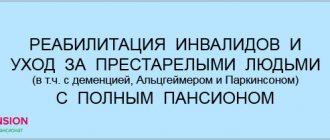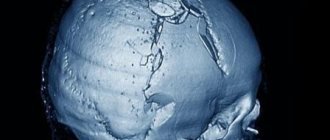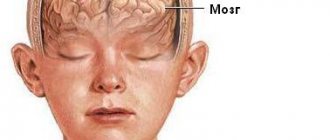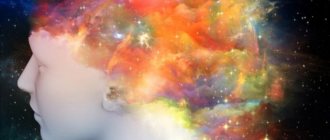Relevance of the issue
It’s not for nothing that doctors know so well what the signs of a head blow and concussion are - this is common and happens to many. From medical statistics you can find out that on average, cerebral concussions account for 75% of cases of damage to the central nervous system. The consequences of injury affect a person’s health and can change his social capabilities, which is why timely prevention of concussion, as well as educating the general public about the symptoms of the phenomenon, comes to the fore.
Many people may experience signs of a concussion after hitting their head. The risk group includes people who use transport, play sports, and work at various production facilities. Concussions are common in children. You can get injured at home. Diagnosis of the condition is difficult, since the manifestations are close to cervical osteochondrosis, vascular insufficiency, and high blood pressure. Doctors say that in about half of the cases the patient’s condition is assessed incorrectly (as more severe than it is, or vice versa).
Symptoms
Treatment after a head impact always depends on the symptoms, while the symptoms themselves and their severity depend on the severity of the injury and its location. The following signs may indicate that the soft tissues of the head have been damaged:
- pain arising from vasospasm;
- the formation of a bruise that forms a lump;
- the presence of a small bruise or extensive hematoma;
- nosebleeds;
- short-term increase in body temperature;
- weakness in the arms;
- confusion or complete loss of consciousness;
- the occurrence of nausea and vomiting.
A bruise to the back of the head may be accompanied by a disturbance in visual function, because the endings of the nerves that are responsible for vision are located in the back of the head. If the frontal part is bruised, bruises may form under the eyes. If the temporal lobe is injured, it can lead to tinnitus. In fact, this is not the entire clinical picture, but if these signs occur, treatment should be immediate.
Terms and phenomena
Before considering what are the signs of a head concussion in a child and an adult, you should refer to the accepted terminology. Brain concussion is the name given to damage to organ tissue, nervous and vascular systems, membranes, and bones. This can happen due to an unsuccessful fall or impact on a hard surface. Irreversible consequences are possible. There is no precise description of the processes occurring in the brain after an impact. Doctors believe that a concussion leads to dysfunction of individual cellular nerve structures, disruption of tissue nutrition and displacement of the layers of the brain relative to each other. Microscopic bruises and swelling form, and blood penetrates from the vessels into nearby tissues. MRI does not show any significant changes in the morphology of the organ.
If signs of a head concussion in an adult or child suggest a severe course, there is a possibility of serious damage to individual elements of the brain. Blood vessels may rupture. This results in loss of consciousness for seconds or even minutes. The duration of unconsciousness allows us to assess the severity of the injury. Coma indicates the worst-case scenario.
Signs, consequences and treatment of head contusion
In everyday life, various injuries often occur, some easier, some more severe. If a head injury occurs, everything may turn out to be much more serious than it might initially seem. When a bruise occurs, closed tissue damage occurs, but the skin remains unharmed. Although in some cases, a bruise of the soft tissues of the head can occur with a violation of the integrity of the skin, and can also be combined with more serious injuries, for example, with a concussion or contusion of the brain or a skull fracture.
A severe head injury is also dangerous because such an injury can cause an extensive hematoma to form, pressing on the brain. The consequences of a bruise can be very diverse, therefore, if you hit your head, you should definitely get examined, even if no serious symptoms are observed.
Primary manifestations
The first sign of a head concussion is the inability to realize what happened as soon as the person regains consciousness. Often you can’t figure out where you are or recognize the people around you. The severity of the condition is assessed by the level of retrograde amnesia. The more significant the concussion, the longer the time period it is impossible to remember. The symptom is explained by a violation of the most important respiratory and regulating heart and circulatory system brain centers.
A symptom that helps in diagnosing a concussion is pale skin in the first hours after injury. The person feels weak, there is noise in the ears, and the head is dizzy. Often there is pain in the head - a strong pulsation in the back of the head. Some people vomit and feel sick. Breathing may become rapid. A concussion may cause your heart rate to increase or slow down. After some time, the parameters return to normal. The pressure may become higher than average, but may remain at an average level - this is determined by injury and concomitant aggressive factors. The temperature remains normal.
How to suspect something is wrong?
Signs and symptoms of a concussion include impaired functionality of the visual organs. Some people experience pain when moving their eyeballs, while others find it difficult to focus their gaze. The pupils may dilate or narrow and become different in size. A typical manifestation of a concussion is the divergence of the eyes when trying to read.
Doctors and professionals know how to recognize a concussion and what to do to help the victim, but any person should have a general understanding of this. In particular, you should imagine what manifestations after an injury or a blow to the head indicate the need to seek qualified help. These include increased activity of the sweat glands and hot flashes, especially pronounced in the facial area. Some feel uncomfortable. Sleep may be disrupted.
Consequences of a head injury
After hitting your head, especially if you hit it hard, certain complications and consequences may arise. Some of them appear immediately, others gradually, maybe even after several months or years. The main consequences if a bruise to the back of the head occurs and no treatment is given:
- Deterioration in performance due to traumatic asthenia;
- problems with concentration;
- Depressive states;
- Deterioration in memorizing information;
- The occurrence of irritability and insomnia;
- Constant headaches, migraines;
- Reaction to weather changes.
To prevent a head blow from becoming a cause of suffering, at the first sign of it you need to be examined and treated.
State progress
As a rule, symptoms of a concussion subside within the next two weeks after the injury. It is important to remember the possibility of long-term health problems. In particular, such a sign of a concussion in an adult or child as a headache can be bothersome for a long time against the background of high blood pressure. It is noted that people who have suffered concussions suffer from more significant, intense, long-lasting headaches.
The signs and symptoms of mild and severe concussions vary depending on the individual's body. They largely depend on age. For example, if a concussion occurs in an infant or young child, there is usually no loss of consciousness at all. At the time of injury, the skin turns pale, which is especially noticeable on the face, and the heartbeat increases. Gradually, the child becomes lethargic and constantly wants to sleep. Regurgitation and vomiting are observed quite often. Some people experience sleep disturbances. Possible concern. If a preschool child is injured, the symptoms usually resolve completely within a couple of days.
Headache treatment
To treat a headache, it is important to determine its cause. At home, you can take a pain reliever and massage your neck and head. However, the doctor prescribes the full regimen based on test results. It may include the following techniques:
- drug treatment (antibiotic therapy for infectious processes, muscle relaxants, anti-inflammatory drugs, drugs to improve blood supply to the brain);
- physiotherapy – a set of techniques based on the effects of ultrasound, heat, electric or magnetic field;
- physical therapy – prescribed for neck diseases that are accompanied by headaches.
Doctors at the Clinical Institute of the Brain recommend not to self-medicate. Modern techniques allow you to quickly and safely get rid of headaches, eliminate its causes and prevent further development of diseases. The doctor will prescribe an effective regimen, but the results of treatment largely depend on following all instructions at home.
Age and manifestations: features
The first symptoms of a concussion in people up to and including middle age are almost always accompanied by loss of consciousness. The older a person is, the higher the likelihood of losing the ability to navigate in time and space immediately after receiving an injury.
Neurological manifestations in mild forms of damage disappear after a couple of weeks. Brain metabolism continues to function abnormally for up to a year, sometimes longer.
Classification of head contusions: symptoms and possible consequences
Head contusions are injuries that most often result from a fall or blow from a blunt object. Often such injuries occur in young people.
Even when there are no symptoms, it is not recommended to ignore head injuries, since they can pose a danger to human health and life.
Injuries can cause a fracture of the base of the skull, concussion and other unpleasant complications, which is why it is necessary to know what to do in case of a head injury and, if necessary, provide first aid.
Frequent symptoms
The most common signs of a head concussion include nausea and vomiting. This is possible while the person is still unconscious. If it is not known what happened to the victim, the gag reflex can suggest a concussion.
After any blow to the head, a person feels pain. This signals a variety of injuries, including concussion. The patient is either too active, or is constantly drawn to sleep, the state is lethargic. Coordination problems may occur, clearly indicating brain damage. At the same time, dizziness is possible.
The key sign of a head concussion is loss of consciousness. The eclipse may last for a long period or be short-lived – just a few seconds. When examining a person, you should pay attention to the pupils - whether the shapes and sizes match.
A convulsive state indicates a concussion. If a person is conscious, he experiences discomfort with loud sounds and too bright light. During a conversation, manifestations of confused consciousness are possible. Often a person cannot remember what happened before the injury occurred. Slurred speech may indicate a concussion.
Causes
The brain has a consistency similar to gelatin. It is protected by cerebrospinal fluid, which sits inside the skull and cushions daily impacts and impacts.
A strong blow to the head, neck, or upper body can cause the brain to jerk forward or backward toward the inner walls of the skull.
Sudden acceleration or deceleration of head movement caused by events such as a car accident or a strong jolt can also cause brain injury.
These injuries affect brain function, usually for a short time, and cause the symptoms and signs of a concussion.
This type of traumatic brain injury can cause bleeding in or around the brain, which can cause symptoms such as prolonged drowsiness and confusion. These symptoms may develop immediately or later.
This brain bleeding can be fatal. It is for this reason that people who suffer a traumatic brain injury should be monitored for several hours after the event and receive emergency care if symptoms worsen.
Is it that simple?
Gradually, the signs of a head concussion become weaker and disappear. If symptoms that appeared shortly after the injury are observed for a long time, the cause may be significant, serious disruptions in brain functionality. There is a possibility of organ swelling, hematoma, soft tissue bruise.
The problem of clarifying the condition is due to the fact that not every person is able to remember what triggered the concussion. It is not easy to immediately determine whether there are concomitant injuries or a mild concussion; no brain areas are affected. For example, there are often cases when the injury that provoked a concussion leads to damage to the vitreous bone of the cranial plate. The condition is not accompanied by external manifestations; when examining the patient, the doctor usually diagnoses a mild concussion. There is a danger of complete absence of symptoms. Gradually, the patient’s condition becomes worse, but it is not always possible to associate this with a fall or blow, which complicates the diagnosis.
Sometimes signs of a head concussion are followed by worsening symptoms, indicating unhealthy pressure on brain tissue. This develops approximately a couple of weeks after the injury. The condition worsens in stages, and the therapeutic course often involves urgent surgery. In an impressive percentage of cases, the outcome of the operation cannot be predicted in advance.
Where did the trouble come from?
A concussion is associated with a bruise, a sudden movement or blow. In the predominant percentage of cases, a concussion is observed against the background of an accident, an injury sustained at work or at home, or sports activity. The spinal column puts an axial load on the cranial bones, which can cause an aggressive mechanical effect on soft tissues when jumping without shock absorption or an accidental unpredictable fall.
The volumes between the skull and soft tissues are occupied by a specific liquid - cerebrospinal fluid. It helps prevent the negative effects of physical activity. If a person is accidentally hit by something, an inertial counter-directional movement of brain tissue occurs inside the skull, which leads to an increase in local pressure. Water hammer occurs. Mechanical possible.
The brain produces forced vibrations that initiate repeated damage. Additionally, injury is observed due to rotational axial displacement, which is explained by impacts on the protrusions of the skull. The stronger and more unpredictable the aggressive influence, the more significant the brain damage.
Consequences: severe and not very
TBI can cause numerous complications and consequences. The most common syndrome is what is called “after a concussion.” This leads to severe headaches days and months, sometimes years after the injury. Sometimes the pain is downright excruciating; patients complain of a splitting headache. At the same time, disturbing thoughts come, and the person himself tends to get irritated over trifles. It becomes a problem for him to concentrate his attention, fall asleep and wake up, and function in society and in the workplace.
If you observe such complications, you should consult a doctor to choose a therapeutic course to alleviate the condition. As a rule, a medication program and a strict work and rest schedule are prescribed. Patients are contraindicated in bright light, which significantly increases pain. Analgesics, sedatives and sleeping pills will come to the rescue. In old age, a program for the prevention and elimination of multiple sclerosis is additionally prescribed.
Treatment
How to treat a head injury should be decided by the doctor, based on the diagnosis. If the bruise does not threaten the health and life of the patient, then treatment is as follows:
- The first days the patient should be completely at rest and adhere to bed rest. Getting out of bed is allowed only if absolutely necessary.
- The patient must impeccably follow all the recommendations of the attending doctor and take the medications prescribed by him;
- For some time after the injury, you need to limit physical activity.
- If the bruise is located on the right side, then it is better to sleep on the left side and vice versa.
- During the recovery period, it is recommended to watch less TV, sit at the computer and breathe more fresh air.
It is very easy to get a head injury. Sometimes it is enough to sneeze, shake your head and hit the table, door or wall. The injury is considered quite mild, but if any alarming symptom appears, it is better to consult a doctor, then recovery will come faster and the consequences of the injury will be avoided.
Head injury: how to help?
The most important treatment for concussion symptoms is first aid. If a person remains conscious all the time or loses it for a very short time, you need to lay the victim horizontally, slightly raising his head. If the patient has lost the creature for a long time, he is turned on his right side and his head is thrown back, facing the surface on which he lies. Next, bend the leg at an angle of 90 degrees, and the arm on the left side. This position will allow air to easily enter the lungs, which means the danger of hypoxia is minimized.
After getting injured, you need to see a doctor. At first, the symptoms of all cases are similar, it is difficult to assess the severity of the damage, and it is important to take an X-ray in time to clarify the diagnosis. Bed rest and absolute rest are recommended for the next 48 hours. You can't watch TV or read. Music is prohibited. Medicines prescribed by your doctor will help you calm down, improve sleep, and get rid of dizziness and headaches.
Head injury: what should parents do?
Lack of awareness of parents in terms of helping a small child with a head injury can result in the most unfavorable consequences. Among them are unnecessary diagnostic procedures (which often show nothing), treatment according to grandmothers’ prescriptions, self-medication with drugs hastily purchased at the pharmacy, as well as sleepless nights for parents and instability of the baby’s nervous system. To avoid all this, it is enough to know the basic rules of behavior in case of traumatic brain injury (TBI) and be guided by them in unforeseen circumstances.
How dangerous are TBIs?
Traumatic brain injury occurs due to head contusions (in children, usually when falling from sofas, chests of drawers, tables and chairs, or from their own height (running and tripping)). It is accompanied by stretching or damage to axons - the long processes of nerve cells that make up all nerve fibers. Normally, these cells conduct impulses, but after injury this function is disrupted and neurological symptoms occur. In addition to axons, blood vessels can also be damaged. Usually the smallest ones are damaged. With severe or repeated injuries, quite large hemorrhages into the brain tissue are possible.
What do we have to do?
After a TBI, it is very important to understand whether and to what extent the brain structures are damaged. Depending on the extent of the damage, brain injury can be mild, moderate or severe. The last 2 types are a reason for hospitalization. Mild TBI can be treated under medical supervision in an outpatient setting.
It is almost impossible to figure out on your own how hard a child was hit. Therefore, it is better to seek help from a specialist - a neurologist. After taking a history and examining the victim, the doctor will decide whether a computed tomography (CT) scan is necessary. This method is most informative for head injuries. Depending on the extent of the changes, a diagnosis will be made and treatment will be prescribed.
The first day is the most important
Neurologists recommend closely monitoring the child’s condition the first day after the injury. At this time, complications may appear.
It is better to let your baby sleep a lot over the course of 24 hours, which will speed up brain recovery. Reasonable rest will prevent re-injuries and reduce the overall load on the body. As prescribed by a doctor and if necessary (headache), the use of Paracetamol or Nurofen is allowed.
You need to return to any usual activities gradually. Cognitive training does not affect the speed of recovery.
Physical activity that risks re-injury should be resumed last (after 10-14 days). However, this does not mean that you need to stay in bed. It is enough to ensure that the child plays calmly, without running, jumping or somersaulting on the bed.
Beware of complications!
Parents need to urgently call an ambulance if, after an injury, their child experiences:
- anxiety, excessive agitation;
- convulsions;
- hearing or vision impairment;
- fever;
- repeated vomiting;
- rigidity, too much tension in the neck muscles (the baby cannot press his chin to his chest);
- numbness of a body area;
- urinary or fecal incontinence;
- severe headache (or worsening).
An alarm signal is also a child’s too deep, restless sleep, when, despite all the efforts of the parents, it is not possible to wake him up.
Knowledge is power. Exercise reasonable caution and take care of your child!
Features of therapy
In most cases, the condition returns to normal within the first week after injury or twice as long. On average, every third case is accompanied by complications of varying severity. The risk of such development is higher if you endure the condition on your feet. Possible post-traumatic neurosis. TBI can trigger epilepsy. A certain percentage of victims require urgent surgery.
In old age, there is a high probability of neurological symptoms and complications that worsen the functioning of the cerebral vascular system. Against the background of an injury, blood pressure may rise, the risk of stroke increases, and the risk of developing Alzheimer's disease increases.
If a person has suffered a concussion, they are placed under observation for the next year. The neurologist checks whether there are any consequences of the injury and how the quality of life changes. If necessary, the doctor recommends a course of treatment.
Symptoms
What can happen to the brain after a stroke? The brain, by inertia, sharply shifts in the opposite direction, so it is damaged not only at the site of the impact, but also on the opposite side, this causes vascular spasms and swelling. Due to edema, intracranial pressure increases.
A severe head injury is often accompanied by fractures of the skull bones, which worsen the person’s condition; the risk of developing an infection in the affected area also increases. In any case, you should consult a doctor immediately.
Symptoms of a head injury are determined by the location and force of the blow:
- A mild bruise is characterized by pain that subsides after a few hours. When the subcutaneous vessels are damaged, a hematoma forms. The victim complains of constant drowsiness, double vision and darkening of the eyes, and sometimes fainting occurs. Symptoms disappear after a few weeks;
- moderate injuries are accompanied by prolonged fainting (several hours), severe headaches, inhibited reactions and impaired awareness of what is happening. Speech is unclear and slow;
- for fractures of the skull bones, the main clinical symptoms are dizziness, vomiting, and nosebleeds;
- contusion of the back of the head is manifested by blurred vision, dizziness, loss of consciousness and general weakness.
In case of serious injury, patients are unconscious for a long time (up to several days), and coma may occur. There is a disturbance in speech, breathing and swallowing, and the pupils may vary in size. Partial or complete memory loss cannot be ruled out.
Pharmacy products: what will help?
If it is necessary to correct the condition after an injury or concussion, Phenobarbital may be prescribed. The drug belongs to the class of sedatives, improves falling asleep and sleep. The well-known drug Finlepsin has a similar effect.
People who have suffered trauma are prescribed drugs that prevent convulsions and inhibit reticular formations. The most accessible medications in this group are hawthorn and motherwort tinctures. Sometimes the doctor advises you to stop on Nozepam or Phenazepam tablets. The drug Phenibut has proven itself well, having a pronounced sedative effect.
To minimize tissue swelling and expand the vascular passages, people who have suffered a shock should take Sermion or Eufillin. The doctor chooses a specific drug based on the severity of the condition, indications and contraindications, and individual characteristics of the body. Sometimes the doctor advises stopping at Trental or Cavinton. The drug “Memoplant” has a good reputation.
What else should I use?
After a brain injury, medications that reduce the formation of free radicals in organic tissues help stabilize the condition. Among pharmaceutical drugs, the popular “Glycine” has this effect. The medicinal compositions Mexidon and Mexiprim are known to have similar qualities.
Stabilization of the condition is possible by installing a dropper. A solution of electrolytes is injected into a vein. This is especially true for severe types of concussion. The program is designed to normalize the concentration of potassium ions in brain cells.
If an injury causes asthenia, if the patient is dizzy, the doctor may recommend B vitamins. Vestinorm and Betaserx show a good effect.
Special case: children were injured
Parents are not always able to find out in time that their child has hit his head. Signs of a concussion include increased activity. The incidence of brain injury in children is much higher than in adults, due to curiosity and poor coordination. Very rarely, a child can adequately assess the level of danger of a situation. The younger the child, the worse his head protection reflexes are, which means that a fall with a greater degree of danger can provoke a TBI.
The signs of a head concussion in an infant or small child differ from the manifestations of a brain injury in an adult. The younger the child, the less pronounced the symptoms. Victims very rarely lose consciousness. You can suspect an injury based on the child's anxiety and tendency to cry. The baby spits up, vomits frequently, the skin turns pale, and the appetite becomes worse. If an infant is injured, the fontanelle may swell. Some children cannot sleep, others are constantly drawn to sleep. But at school age, those injured lose consciousness more often than infants. At this age there is already a danger of minor amnesia. The child complains of a sore head, sweats profusely, is apathetic or irritable, capricious, and prone to crying. Checking the pressure shows instability.









